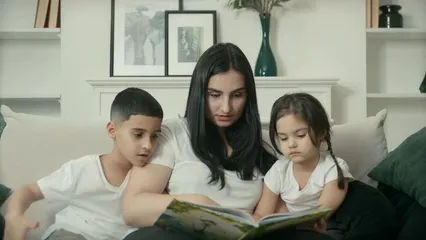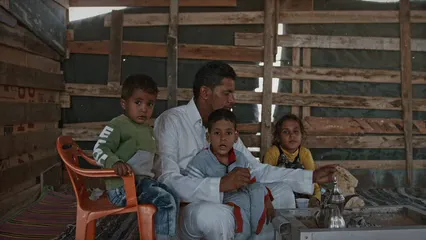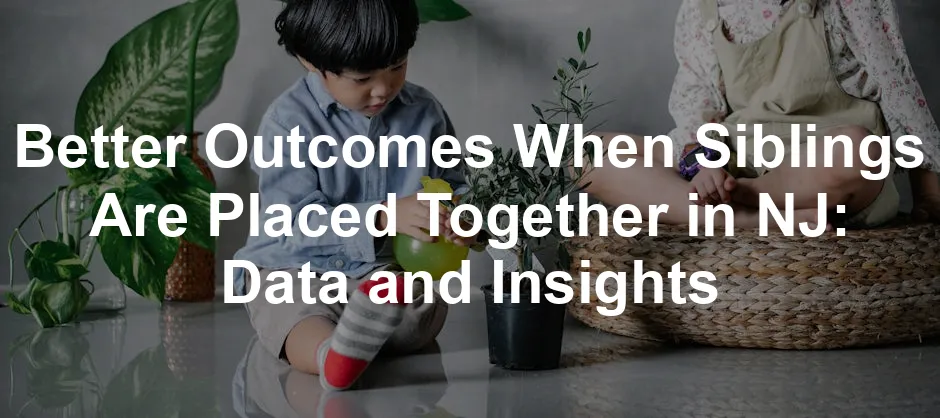Introduction
Sibling placements in the foster care system hold significant importance. Keeping siblings together can improve emotional and behavioral outcomes for children. In this section, we’ll focus on New Jersey data regarding these placements and their impact.
If you’re looking to deepen your understanding of sibling dynamics, check out Sibling Relationships: A Guide for Foster Parents. This book offers insights into how to navigate the complexities of sibling interactions in foster care, ensuring you have the tools to create a nurturing environment.
Summary and Overview
In New Jersey, approximately 80% of sibling groups are placed together at entry into care. This statistic highlights the state’s commitment to maintaining these critical connections. Sibling relationships play a vital role in child development, serving as a source of support and stability. Research shows that children who stay close to their siblings adjust better to the foster care environment.

Key statistics indicate that children placed with siblings report fewer emotional issues. They experience less trauma and disruption during their stay in foster care. However, challenges remain. Many sibling groups are still separated due to various systemic barriers. Finding homes willing to accept multiple children can be difficult, impacting the well-being of these young ones.
To further explore the intricacies of foster care, consider reading The Foster Care Survival Guide. This book provides practical advice and insights to help navigate the often-challenging foster care landscape.
The Importance of Sibling Relationships in Foster Care
Emotional and Developmental Needs
Sibling relationships provide essential emotional support. When children enter foster care, they often face feelings of loss and anxiety. Having a sibling nearby can ease this transition. Siblings act as a source of comfort during uncertain times.
Research shows that sibling bonds can serve as protective factors. They help children navigate emotional challenges and promote resilience. For instance, studies report that about 60% of children in foster care feel lost when separated from their siblings. Such feelings can exacerbate the already challenging experience of entering care.
Moreover, siblings aid in emotional regulation. They offer companionship, helping each other cope with new environments. This interaction fosters social skills and emotional intelligence, essential for healthy development. Overall, maintaining sibling connections is crucial for the emotional and developmental stability of children in foster care.

If you’re interested in understanding emotional intelligence better, check out Emotional Intelligence 2.0. It provides tools to improve your emotional skills, which can be beneficial for both foster parents and children.
Positive Outcomes of Joint Placement
Joint sibling placements lead to greater stability in foster care. Children placed together experience fewer placement disruptions. They also show lower rates of behavioral problems. In fact, statistics reveal that siblings placed together are significantly more likely to achieve permanency, whether through adoption or reunification.
In New Jersey, recent data illustrates these positive outcomes. Children in joint placements report better emotional well-being, improved school performance, and stronger peer relationships. This indicates that sibling placements not only benefit the children involved but also enhance overall family dynamics.

For a deeper understanding of how trauma affects children, consider reading The Body Keeps the Score. This book explores the impact of trauma and how understanding it can foster better care for children in need.
Challenges to Sibling Placement
Despite the known benefits, several challenges hinder sibling placements. One common issue is the limited availability of foster families willing to take in sibling groups. Many families prefer to foster individual children, making it hard for siblings to stay together.
Another challenge arises from the diverse needs within sibling groups. Some children may require specialized care, complicating placements. Additionally, the issue of serial entry, where siblings enter care at different times, further complicates the effort to keep them together.
Addressing these challenges requires systemic changes. Increased awareness and recruitment of foster families willing to take sibling groups are essential. By overcoming these barriers, we can work towards preserving these vital sibling connections in New Jersey’s foster care system.

For a comprehensive guide to foster care, consider The Essential Guide to Foster Care. This resource provides insights into navigating the complexities of foster care, including sibling placements.
Positive Outcomes of Joint Placement
Joint sibling placements lead to greater stability in foster care. When siblings are placed together, they report feeling more secure. This sense of security helps them adjust better to their new environment.
One key outcome is fewer placement disruptions. Research shows that siblings placed together experience significantly less instability in their homes. Less disruption means children can form healthier attachments with caregivers.
Lower rates of behavioral problems also emerge from joint placements. Children benefit from having a sibling to lean on during stressful times. The presence of a brother or sister helps reduce anxiety and feelings of isolation. Studies indicate that siblings in joint placements often exhibit fewer emotional issues.
Moreover, joint placements increase the likelihood of adoption and reunification. When siblings are together, they provide each other with emotional support. This support enhances their chances of successful placement outcomes. In New Jersey, data highlights these trends. Children placed with siblings are more likely to achieve permanency. They have a higher success rate in being adopted or reunited with their families.

To help foster creativity and bonding, consider getting a Crayola Inspiration Art Case Coloring Set. Art can be a wonderful way for siblings to express themselves and bond during their time in care.
New Jersey’s statistics show that around 80% of sibling groups remain together at placement. This commitment reflects the state’s understanding of the importance of sibling bonds. Children benefit in numerous ways, including better emotional well-being and academic performance. In fact, those placed together often report stronger peer relationships and improved school engagement.
Ultimately, the stability gained from joint placements leads to healthier development. Siblings bolster each other’s resilience, helping them navigate the challenges of foster care. These positive outcomes underscore the necessity of prioritizing sibling placements within the child welfare system. By keeping siblings together, we can foster a nurturing environment that supports their growth and well-being.

Challenges to Sibling Placement
Despite the advantages, several challenges hinder sibling placements. One major obstacle is the limited availability of foster families willing to take sibling groups. Many families prefer to foster single children. This preference complicates efforts to keep siblings together.
Another challenge arises from diverse needs within sibling groups. Some children may have special requirements that differ from their siblings. Caseworkers often face difficulties matching these specific needs with appropriate foster homes. This can lead to separations that impact the emotional health of the children involved.
Additionally, the issue of serial entry into care further complicates sibling placements. Siblings may enter the system at different times or through various agencies. Often, this results in siblings being placed apart, which can create additional emotional distress.
Myths and misconceptions about sibling rivalry also play a role. Some professionals believe that placing siblings together may escalate conflicts. Such beliefs can discourage joint placements, despite evidence showing that siblings often support each other during transitions.
Addressing these challenges requires systemic changes. Increased awareness and recruitment of families willing to foster sibling groups are critical. It’s vital to educate child welfare workers about the importance of sibling bonds. By tackling these barriers, we can work toward keeping siblings together in New Jersey’s foster care system.

Policies and Initiatives Supporting Sibling Placements in NJ
State Legislation and Guidelines
New Jersey has taken significant steps to support sibling placements in the child welfare system. The state’s legislation prioritizes keeping siblings together whenever possible. This commitment stems from the understanding that sibling relationships are vital for emotional stability.
One key legislative mandate is that caseworkers must make reasonable efforts to place siblings together. This requirement ensures that siblings maintain their connections during challenging times. In addition, New Jersey’s Department of Children and Families (DCF) operates under guidelines that favor sibling placements. Programs have emerged to enhance these policies, focusing on the emotional benefits of sibling bonds.

Programs aimed at promoting sibling connections include various initiatives that provide resources and training to foster families. These programs help caregivers understand the significance of sibling relationships and how they contribute to children’s well-being. By prioritizing sibling placements and creating supportive environments, New Jersey aims to foster stability for children in foster care.
For those interested in exploring family dynamics further, consider reading The Power of Sibling Relationships. This book delves into the importance of sibling connections and how they shape our lives.
Innovative Practices
New Jersey has implemented innovative practices to enhance sibling placements. One notable initiative is the “Siblings in Best Setting” incentive program. This program encourages foster families to accept larger sibling groups by offering additional support and resources. This approach recognizes the unique challenges that come with caring for multiple siblings and aims to alleviate some of the burdens on foster families.
Another successful practice involves training for foster families on the importance of sibling relationships. This training emphasizes how siblings can serve as a source of emotional support and stability. By equipping foster families with this knowledge, New Jersey seeks to improve outcomes for children placed together with their siblings.
These innovative practices not only aim to keep siblings together but also to create a nurturing environment conducive to their healthy development. As New Jersey continues to refine its policies and programs, the focus remains on ensuring that sibling bonds are valued and maintained throughout the foster care journey.

Data Insights: NJ Sibling Placement Statistics
Current Statistics
Recent data highlights the importance of sibling placements in New Jersey’s foster care system. Currently, approximately 80% of sibling groups are placed together upon entry into care. This statistic reflects the state’s commitment to maintaining these essential family ties.

The benefits of joint placements are clear. Children placed with siblings report better emotional health, fewer behavioral issues, and a greater sense of security. Studies indicate that siblings placed together experience significantly lower rates of placement disruptions. This stability is crucial for their overall development and well-being.
Moreover, joint placements increase the likelihood of achieving permanency, whether through adoption or reunification. Children who maintain their sibling connections are more likely to succeed in their foster placements. They often demonstrate improved academic performance and stronger peer relationships. These factors contribute to a smoother transition into new environments.
In summary, the data underscores the positive impact of sibling placements on emotional, behavioral, and permanency outcomes. New Jersey’s focus on keeping siblings together is not just a policy; it’s a commitment to enhancing the lives of children in foster care.

If you’re curious about the long-term effects of sibling relationships, consider reading The Complete Book of Sibling Relationships. It provides a thorough exploration of how sibling dynamics impact personal development throughout life.
Comparative Analysis
New Jersey’s sibling placement data stands out against national statistics. Approximately 80% of sibling groups in New Jersey are placed together at initial entry into foster care. Nationally, however, estimates suggest that 53% to 80% of siblings are separated during placements. This striking contrast emphasizes New Jersey’s commitment to maintaining these vital connections.
Research indicates that children placed with siblings experience better outcomes. New Jersey’s approach leads to greater placement stability and fewer behavioral issues. National data shows that siblings who remain together have higher rates of reunification and adoption. This correlation underscores the importance of prioritizing sibling placements.
Trends in New Jersey suggest that joint placements are not just beneficial but essential for children’s emotional and psychological well-being. Policymakers should consider these outcomes when shaping future legislation. Supporting sibling placements means fostering healthier environments for children in care.
The implications for practice are clear: child welfare agencies must prioritize sibling placements to improve outcomes. This approach will help children cope better during transitions and enhance their overall development. By focusing on keeping siblings together, we can create lasting positive change in the foster care system.

Conclusion
Keeping siblings together in foster care is crucial for their emotional and psychological well-being. New Jersey’s data shows that these joint placements lead to improved outcomes. Children who stay with their siblings often experience better emotional health, fewer behavioral issues, and increased chances of adoption or reunification.
As advocates for children in care, we must continue pushing for policies that support sibling placements. By prioritizing these connections, we can ensure a more stable and nurturing environment for all children. Let’s work together to enhance the foster care system and keep siblings together.
To help foster a sense of community, consider engaging in family activities. A great way to do this is by utilizing Family Board Games Set. Games can help strengthen sibling bonds and create lasting memories.
FAQs
Why is it important for siblings to be placed together in foster care?
Siblings provide emotional support and stability during transitions. This bond helps reduce feelings of anxiety and loss. They also contribute to each other’s social and emotional development.
What are the statistics on sibling placements in New Jersey?
In New Jersey, around 80% of sibling groups are placed together. This high percentage reflects the state’s dedication to maintaining sibling relationships in foster care.
What challenges do child welfare agencies face in keeping siblings together?
Agencies often struggle with limited foster family availability for sibling groups. Differences in needs among siblings can complicate placements. Additionally, siblings may enter care at different times, leading to separation.
How does sibling placement affect a child’s adjustment to foster care?
Sibling placements significantly enhance a child’s adjustment to foster care. When siblings are together, they provide emotional support and stability during a tumultuous time. This connection helps ease feelings of anxiety and loss often experienced during placement transitions.
What can be done to improve sibling placements in foster care?
Improving sibling placements in foster care requires concerted advocacy and policy changes. First, we need to raise awareness about the importance of keeping siblings together. This awareness can lead to more families stepping up to foster sibling groups.
Please let us know what you think about our content by leaving a comment down below!
Thank you for reading till here 🙂
For a comprehensive analysis of crime statistics in Camden, New Jersey, you can check out this article on Camden New Jersey Crime Statistics.
All images from Pexels




